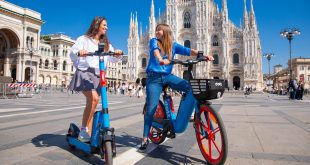By Duncan Robertson, UK general manager, Dott
This piece first appeared in the February edition of BikeBiz magazine – get your free subscription here
The new year is off to a strong start for active travel, with the announcement by Active Travel England of almost £33 million of new funding to make places more walkable and cyclable. But to encourage a major modal shift, and convince more people to use environmentally friendly forms of travel across our cities, this investment should consider the needs of shared e-scooter and e-bike users as well as traditional active forms.
Our own research reveals that as our service matures, our riders are becoming more diverse. The gender balance is becoming more evenly split, and we are seeing a broader age range as more people discover how shared e-scooters and e-bikes can be useful to them in their daily lives.
This growing diversity means e-scooters and e-bikes are bringing new people to active travel, helping to create cleaner and more pleasant cities. They have also become a regular, relied-upon form of transport, with Dott’s peak time of use now in the morning and evening rush hours, as opposed to occasional leisure use.
Alternative to ownership?
Whilst purchasing, maintaining, and storing a bike can often be prohibitively expensive for some people, shared fleets remove these barriers by providing an affordable alternative without the initial investment, or unexpected repair costs.
With maintenance handled by a team of in-house experts, and vehicle checks at every battery swap, shared e-scooters and e-bikes can be even more reliable and safer than privately owned alternatives.
When people choose e-scooters or e-bikes over mechanical cycling, that doesn’t mean a compromise in terms of health. Research has shown that e-bike users actually benefit from similar physical gains to traditional cyclists, because they are more likely to travel further and for longer.
And our own research from a recent rider survey also shows that 41% of our users report using bikes (shared and private) more since they started to use Dott. This is likely due to people gaining confidence cycling in their city, having overcome a perceived concern over safety.
Safety first
Despite these benefits, some barriers remain to shared e-scooter and e-bike use. But if policymakers and city authorities act, there is an opportunity to further drive up their use, and with it improve the air quality and reduce congestion.
65% of Dott’s riders (and 74% of women riders) say that improving infrastructure would make using Dott feel safer. If we want to see more people replacing their cars with sustainable alternatives, then resolving this is key.
The commitment from Active Travel England of more funding for infrastructure is clearly the right start. But to have a real impact, and bring new people to active travel, it must be invested in the right way. Our experience of operating across some of Europe’s major cities has witnessed a wide range of successful infrastructure measures come to light.
Segregated cycle lanes, low-traffic neighbourhoods, reducing speed limits of cars, congestion charges or banning cars altogether in central areas are all effective ways of making vulnerable road users feel safer. These methods all focus on reducing the dominance of cars in our shared public spaces.
Beyond that approach, other specific initiatives can target increasing e-scooter and e-bike use. For users to have the best possible experience, a consistent approach across cities is crucial, ensuring that riders know that they can expect the same from the service wherever they are in a city, and not just in the centre but to the suburbs they live in as well.
An effective service would allow riders to easily find or park a vehicle, supported by a high density of parking spaces. We recommend that there is a parking spot available at least every 250-500 metres (two-five minute walk).
And whilst slow and no-go zones for e-scooters and e-bikes can be useful tools to protect pedestrians, these should be minimised in favour of other methods (such as cycle lanes) to allow riders to move around their city efficiently and directly without compromising safety.
Convenience is key
Schemes should also consider that people have different transport needs at different times and occasions. Close integration between transport modes allows people to effectively plan their journey, choose the best option that suits them at any given time, and combine scooter and bike trips with public transport for longer trips.
The next phase of this integration is the ability to purchase a combination of transport forms within a single translation. The more seamless journey planning and travel can be, the easier it is to compete with cars, which traditionally have offered the most flexible and direct way to move around.
If combined, policymakers and city authorities can take steps to restrict car use in our cities, and encourage different forms of micromobility and active travel. With the right infrastructure, our cities can be transformed with more people choosing low-carbon and sustainable alternatives, without having to compromise on ease, affordability and reliability.
Dott is a European micromobility operator founded by Henri Moissinac and Maxim Romain, with the mission to free our cities with clean rides for everyone. Dott currently operates over 40,000 e-scooters and 10,000 e-bikes in top cities in Belgium, France, Israel, Italy, Poland, Spain, Sweden and the UK.
 micromobilitybiz Delivering news updates to the micromobility industry, focusing on e-bikes, e-scooters and green transport
micromobilitybiz Delivering news updates to the micromobility industry, focusing on e-bikes, e-scooters and green transport




